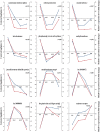Transcriptomic variation of hepatopancreas reveals the energy metabolism and biological processes associated with molting in Chinese mitten crab, Eriocheir sinensis
- PMID: 26369734
- PMCID: PMC4570184
- DOI: 10.1038/srep14015
Transcriptomic variation of hepatopancreas reveals the energy metabolism and biological processes associated with molting in Chinese mitten crab, Eriocheir sinensis
Abstract
Molting is a critical developmental process for crustaceans, yet the underlying molecular mechanism is unknown. In this study, we used RNA-Seq to investigate transcriptomic profiles of the hepatopancreas and identified differentially expressed genes at four molting stages of Chinese mitten crab (Eriocheir sinensis). A total of 97,398 transcripts were assembled, with 31,900 transcripts annotated. Transcriptomic comparison revealed 1,189 genes differentially expressed amongst different molting stages. We observed a pattern associated with energy metabolism and physiological responses during a molting cycle. In specific, differentially expressed genes enriched in postmolt were linked to energy consumption whereas genes enriched in intermolt were related to carbohydrates, lipids metabolic and biosynthetic processes. In premolt, a preparation stage for upcoming molting and energy consumption, highly expressed genes were enriched in response to steroid hormone stimulus and immune system development. The expression profiles of twelve functional genes detected via RNA-Seq were corroborated through real-time RT-PCR assay. Together, our results, including assembled transcriptomes, annotated functional elements and enriched differentially expressed genes amongst different molting stages, provide novel insights into the functions of the hepatopancreas in energy metabolism and biological processes pertaining to molting in crustaceans.
Figures




References
-
- Panganiban G., Sebring A., Nagy L. & Carroll S. The development of crustacean limbs and the evolution of arthropods. Science. 270, 1363–1366 (1995). - PubMed
-
- Hopkins P. M. Limb Regeneration in the Fiddler Crab, Uca pugilator: Hormonal and Growth Factor Control. Am Zool. 41, 389–398 (2001).
-
- Morris S. et al. The adaptive significance of crustacean hyperglycaemic hormone (CHH) in daily and seasonal migratory activities of the Christmas Island red crab Gecarcoidea natalis. J Exp Biol. 213, 3062–3073 (2010). - PubMed
-
- Jung H., Lyons R. E., Hurwood D. A. & Mather P. B. Genes and growth performance in crustacean species: a review of relevant genomic studies in crustaceans and other taxa. Rev Aquacult. 5, 77–110 (2013).
-
- Kurup N. The intermolt cycle of an anomuran, Petrolisthes cinctipes Randall (Crustacea-Decapoda). Biol Bull. 127, 96–107 (1964).
Publication types
MeSH terms
LinkOut - more resources
Full Text Sources
Other Literature Sources

